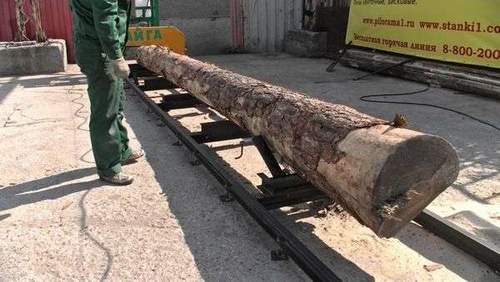How to Properly Saw a Log on a Tape
Is your band sawmill installed and all the necessary settings made? So it’s time to start directly to the sawing process itself. In order to get a really high-quality material, you need to correctly install the log and fix it with special clamps.
Next, it is necessary to calculate, depending on the diameter of the log, the approximate amount of material that can be obtained from this log.
The quality also depends on the correct calculation of the quantity and type of material that you want to get from this log.

Having gained further experience, one look at the log will be enough, and you will already know how much and what kind of material you can get from it. Learn to accurately determine where the top is and where the butt of the log is. The butt part, as a rule, is larger in diameter than the top. And this largely affects the thickness of the croaker.
How to calculate a log
So, you measured the diameter of the log, and it is measured from the top. We calculate the approximate amount of material according to the diameter and proceed to further actions.
At first.
We pay attention to all the bends and bulges of the log. A perfectly smooth trunk is rare. Therefore, we try to turn it so as to get as little waste as possible from it, such as croaker. When the log is laid and fixed, it is worth making sure that it passes freely between the guide rollers.
Set the diameter of the sawmill on the sawmill ruler, and to this size add the largest height of the bulge of the log. This is the bulge that is higher than the diameter of the top or the narrowest part of the log.
Using a standard roulette, measure the height of the highest part, and from this size you start counting the dimensions of the necessary material, taking into account the cut size, which is from 2 to 5 mm.
How to Properly Saw a Log on a Tape
Secondly.
As soon as the width of the cut has reached the required size, and the remainder of the height of the log has reached the desired size, it is turned over. That is, if you are sawing a timber, for example, by 150, then the width of the cut and the height of the remainder of the log should correspond to this value, even be greater, taking into account the removal of the croaker.
Next, we know the final size of the material that needs to be obtained, and we will get it.
To do this, after turning the log, start the calculation from the final size to the full use of the height of the log, but do not forget to take into account the size of the cut, which, as we already know, is from 2 to 5 mm.
For example. You have a log on the flyover that you cut to a size of 260 mm. Turn the log over and continue.
The end result we want to achieve is a gun mount, 150 mm thick. Further, in a simple way, considering that 260 mm-150 mm = 110 mm. We get as much as 110 mm of additional material thickness. And it is precisely it that must be correctly calculated.
We take this additional size and calculate, to get a chopping block, which has a size of 50 mm, 110-50 = 60, do not forget to cut it, but with us it is 2 mm, 60-2 = 58 mm, then a strain equal to 25 mm, 58.25-2 = 31 mm, foothill 20 mm, 31-20-2 = 9 mm.
As you can see, from our calculations, we get a 9 mm croaker, 20 mm subfisher, 25 mm cleft and 50 mm chopping block. And the final size will be 150 mm.
Possible mistakes
As you can see, there is nothing complicated here. Often, inexperienced sawmills make a mistake in the calculations when they start counting from zero. For example, if the final size of the material is 150 mm, then there is no need to add 2 mm to the cut, otherwise it will turn out 150 2 = 152. There should not be such an error, the cut is calculated only between the material, for example, a 50 mm board and 150 mm carriages , we obtain, as described above, 150 50 2 = 202 mm.
If you need to obtain edged material, turn the log 90 degrees and perform the same manipulations as described above.
So you saw your first log, look at the quality of the material and dimensional accuracy. Make sure your calculations are correct. The main mistake in the calculations is that they forget to take into account the size of the cut. Try to take this fact into account. And do not make such mistakes.
In the future, when you gain experience, the calculation will take place automatically in your head, it will be enough to look at the log.
We are sure that you will succeed, we wish you success in your work.